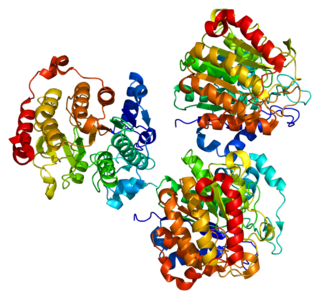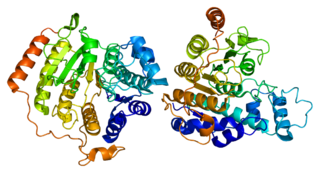Protein AATF is a protein that in humans is encoded by the AATF gene. [5] [6] [7]
Protein AATF is a protein that in humans is encoded by the AATF gene. [5] [6] [7]
The protein encoded by this gene was identified on the basis of its interaction with MAP3K12/DLK, a protein kinase known to be involved in the induction of cell apoptosis. This gene product contains a leucine zipper, which is a characteristic motif of transcription factors, and was shown to exhibit strong transactivation activity when fused to Gal4 DNA binding domain. Overexpression of this gene interfered with MAP3K12 induced apoptosis. [7]
Apoptosis-antagonizing transcription factor has been shown to interact with:

Transcription factor Sp1, also known as specificity protein 1* is a protein that in humans is encoded by the SP1 gene.

Myogenin, is a transcriptional activator encoded by the MYOG gene. Myogenin is a muscle-specific basic-helix-loop-helix (bHLH) transcription factor involved in the coordination of skeletal muscle development or myogenesis and repair. Myogenin is a member of the MyoD family of transcription factors, which also includes MyoD, Myf5, and MRF4.

c-Jun is a protein that in humans is encoded by the JUN gene. c-Jun, in combination with c-Fos, forms the AP-1 early response transcription factor. It was first identified as the Fos-binding protein p39 and only later rediscovered as the product of the JUN gene. c-jun was the first oncogenic transcription factor discovered. The proto-oncogene c-Jun is the cellular homolog of the viral oncoprotein v-jun. The viral homolog v-jun was discovered in avian sarcoma virus 17 and was named for ju-nana, the Japanese word for 17. The human JUN encodes a protein that is highly similar to the viral protein, which interacts directly with specific target DNA sequences to regulate gene expression. This gene is intronless and is mapped to 1p32-p31, a chromosomal region involved in both translocations and deletions in human malignancies.

Histone deacetylase 1 (HDAC1) is an enzyme that in humans is encoded by the HDAC1 gene.

Histone deacetylase 2 (HDAC2) is an enzyme that in humans is encoded by the HDAC2 gene. It belongs to the histone deacetylase class of enzymes responsible for the removal of acetyl groups from lysine residues at the N-terminal region of the core histones. As such, it plays an important role in gene expression by facilitating the formation of transcription repressor complexes and for this reason is often considered an important target for cancer therapy.

DNA-directed RNA polymerase II subunit RPB3 is an enzyme that in humans is encoded by the POLR2C gene.

DNA-directed RNA polymerase II subunit RPB11-a is an enzyme that in humans is encoded by the POLR2J gene.

Histone deacetylase 4, also known as HDAC4, is a protein that in humans is encoded by the HDAC4 gene.

Histone deacetylase 6 is an enzyme that in humans is encoded by the HDAC6 gene.

PRKC, apoptosis, WT1, regulator, also known as PAWR or Prostate apoptosis response-4 (Par-4), is a human gene coding for a tumor-suppressor protein that induces apoptosis in cancer cells, but not in normal cells.

The testicular receptor 2 (TR2) also known as NR2C1 is protein that in humans is encoded by the NR2C1 gene. TR2 is a member of the nuclear receptor family of transcription factors.

Myocyte-specific enhancer factor 2A is a protein that in humans is encoded by the MEF2A gene. MEF2A is a transcription factor in the Mef2 family. In humans it is located on chromosome 15q26. Certain mutations in MEF2A cause an autosomal dominant form of coronary artery disease and myocardial infarction.

Histone deacetylase 9 is an enzyme that in humans is encoded by the HDAC9 gene.

Myocyte-specific enhancer factor 2D is a protein that in humans is encoded by the MEF2D gene.

Histone deacetylase 7 is an enzyme that in humans is encoded by the HDAC7 gene.

Retinoblastoma-binding protein 8 is a protein that in humans is encoded by the RBBP8 gene.

Metastasis-associated protein MTA2 is a protein that in humans is encoded by the MTA2 gene.

BCL-6 corepressor is a protein that in humans is encoded by the BCOR gene.

Histone deacetylase 8 is an enzyme that in humans is encoded by the HDAC8 gene.

Mitogen-activated protein kinase 11 is an enzyme that in humans is encoded by the MAPK11 gene.
This article incorporates text from the United States National Library of Medicine, which is in the public domain.